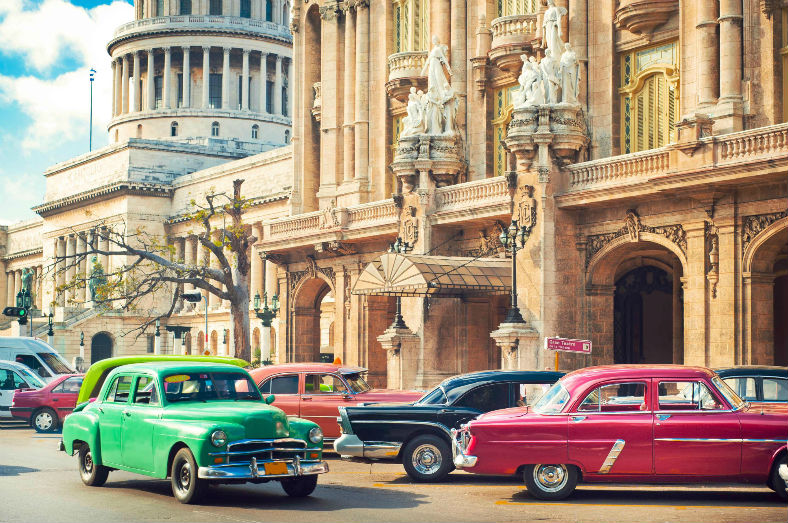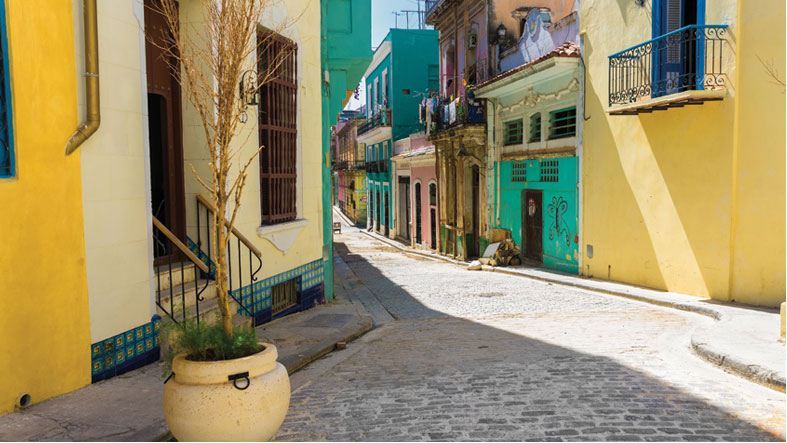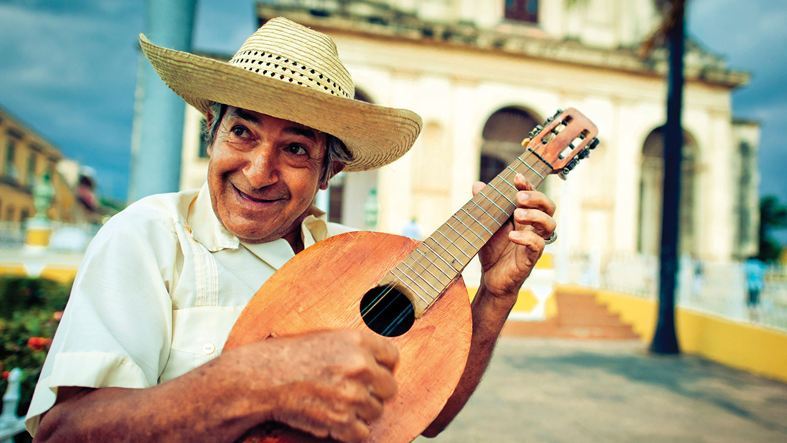When Roger Gibbs and his wife Anne joined Captain’s Choice for the Equatorial Explorer by Private Jet, they couldn’t wait to visit Cuba for the first time. In search of the ultimate classic car, charming Havana was waiting with open arms...
Havana has always been top of my destination wish list, largely due to my obsession with the 50s and 60s American cars I knew I would find there. Cuba was effectively frozen in time when Castro seized power in 1959 and the last of the cars that cruise the streets are still the originals. I found special moments at every opportunity, standing on street corners watching the parade go by against a backdrop of magnificent Spanish colonial buildings inexorably seeping into decay.
Classic cars parked in Havana, Cuba.
A short spin around Havana in one of these classic cars seemed the right way to see the city, but which model should I choose? And then I saw it: a pink ’49 Studebaker convertible, appropriate as I have a ’53 model. The owner assured me of its authenticity. I certainly hadn’t seen any others like it. I think I found the Last Studebaker in Havana.
Our schedule was somewhat tight so we negotiated a short 25 minute drive out to Plaza de la Revolución and back, just to get the feel of things. Dominated by a tall Soviet style tower and surrounded by government buildings, this is the square where over the years Castro addressed more than a million Cubans. The car’s owner now handed us over to his non English speaking colleague Rodolfo and we set off. An open convertible was the perfect way to see Havana, ambling slowly along the uncrowded streets admiring the fascinating architecture.
Buildings in Old Town, Havana, Cuba.
Closer inspection of the car showed it to be in need of some care. It had no interior trim, its convertible hood was long gone and we were witness to strange displays on the instrument panel and a decidedly non Studebaker steering wheel. But what ambience!
At the Plaza we viewed the 109 metre tower to the memory of Cuba’s national hero, Jośe Marti, and were bemused by the enormous outline of Che Guevara on the nearby Ministry of Interior building. On leaving, I said to Anne ‘the engine sure doesn’t sound very healthy’ and as if on cue, the car died just minutes later. We were unfazed – it’s a common occurrence in a classic car!
Quick as a flash Rodolfo hopped out, opened the boot and propped it open with a stick, possibly as an alert to any cars coming behind, then jogged away. I was a touch concerned but then we saw he was carrying a plastic bottle.
Presumably our problem was simply a lack of fuel. As we sat there waiting in the pleasant sunshine, a policewoman came up to direct the infrequent cars around us. In due course Rodolfo came back and poured his bottle’s contents into a hole in the boot; petrol is very expensive so it was probably ethanol. The engine restarted, and running hesitantly, we recommenced our sedate cruising pace and re-entered the residential streets.
Local musician in Havana, Cuba.
Suddenly we stopped beside a park, Rodolfo said ‘John Lennon’ and pointed beyond the bushes. Regarding this as an instruction we got out and started to stroll around the park. As soon as our backs were turned, Rodolfo had he engine hood up on the Stude and his spanners out. Lennon’s music was originally banned by Castro and it took him years to realise that Lennon was a fellow ‘dreamer’ which led to the unveiling of the statue in this very park, somewhat to the bemusement of the Cubans who all the while had been listening to Lennon’s music via smuggled tapes. We kept an eye on the running repairs and politely continued our study of park and statue until we saw the hood close and spanners put away.
With the engine running smoothly, Rodolfo gave us the grand tour of Havana through the streets of the rich and poor; for indeed even in Cuba all are not equal. We admired the attractive cigar-smoking ladies, cruised along the sea front and beside the old fort guarding the city and past the railway station with all its hustle and bustle. Some hours later Rodolfo returned us to our hotel, by which time I was wondering how far a Studebaker could go on a bottle of sugar cane juice.
From remote islands such as The Azores, Easter Island and Tahiti, to the colonial cities of Antigua and Panama and then the stunning wildlife in the Galapagos and the Amazonian basin - The 22-day Equatorial Explorer by Private Jet is truly unique. Prices start from $55,000* per person and are all-inclusive.
Click here to find out more or contact your Travel Associates consultant.















